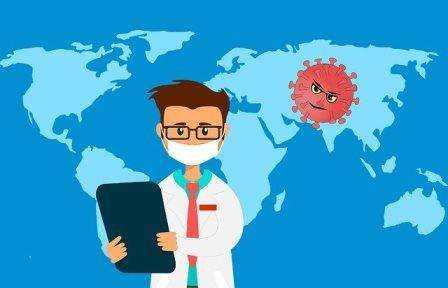Q- Name one example of each of diseases spreading by air, water, and sexual act.
Answer- One example of diseases spreading by air: Chickenpox
One example of diseases spreading by water: Cholera
One example of diseases spreading by sexual acts: AIDS (Acquired immunodeficiency syndrome)
Exams Help
We hope these examples of different diseases are enough simple to learn and remember easily for your exams.
If you want some other examples of diseases that spread through these mediums so you can read the content provided below.
There we are going to tell you about these diseases and their examples. So, should also check them out. This is going to be very helpful for you.
Airborne Disease
Airborne diseases are those diseases that spread only through the air. These diseases are either bacterial or viral but the common thing in them is that they all spread through air contact.
The disease agents of airborne diseases are only transmitted through small respiratory droplets.
These droplets are expelled when someone who is suffering from airborne disease sneezes, laughs, coughs, or otherwise exhales in some other way.
The disease agents of airborne diseases (bacteria or viruses) can travel along with air currents, cling to surfaces, or linger in the air, where they are eventually inhaled by someone else.
The transmission of airborne diseases can occur over relatively long distances and spans of time.
If you go into the room that any infected person coughed in minutes before, it could be a danger for you too. This makes it possible for airborne diseases to infect larger numbers of people in a short time.
As these diseases are airborne so it is more difficult to determine the causes of these diseases due to a lack of person-to-person contact.
With the past COVID-19 pandemic, you may have become more conscious about the air you breathe and the surfaces you touch with any of your body parts.
Disease transmission can happen in different ways, but the most unpredictable method is via air medium. These diseases have varying capabilities.
Airborne diseases are enough dangerous as they can travel distances greater than 6 feet and remain infectious in the air from minutes to hours.

Examples of Airborne diseases
There are different airborne diseases that have different symptoms but the most common thing in all of them is that these diseases spread through the air medium.
The range of spreading of agents of these diseases varies from the variety of diseases.
Some of the examples of airborne diseases are given below in a list you can read them all.
- The common cold
- Tuberculosis (TB)
- Diphtheria
- Influenza
- Chickenpox
- Whooping cough (pertussis)
- Coronavirus (COVID-19)
- Mumps
- Measles
Symptoms of Airborne diseases
We all know that different diseases have different symptoms but there are some common symptoms in most of air-borne diseases. Here we are providing you with some of the common symptoms of airborne diseases.
Some of the common symptoms of all the airborne diseases are given below-
- Inflammation of the nose, sinuses throat, or lungs
- coughing
- congestion
- sneezing
- swollen glands
- headache
- runny nose
- sore throat
- loss of appetite
- fever
- body aches
- fatigue
Water-Borne diseases
Water-borne diseases are those diseases that spread through water mediums. The agent of these diseases mainly spread through the water medium. That is why these diseases are called water-borne diseases.
There are different water-borne diseases and all of them have different signs & symptoms.
Some of the examples of water-borne diseases are given below so that you can understand them easily.
- Cholera
- Scabies
- Worm infections
- Diarrhea
- Hepatitis
- Gastroenteritis
- Typhoid
- Amebiasis
- Giardiasis
- Campylobacteriosis
- Amoebiasis
